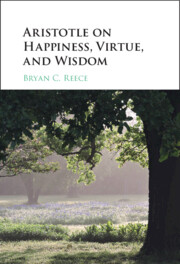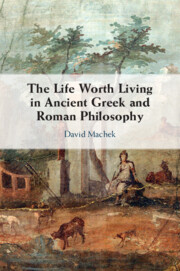132 results
14 - The New York School’s Queer Happiness
- from Queer Literary Movements
-
-
- Book:
- The Cambridge History of Queer American Literature
- Published online:
- 17 May 2024
- Print publication:
- 06 June 2024, pp 255-268
-
- Chapter
- Export citation
Chapter 8 - What It Means to Be a God
-
-
- Book:
- Boethius’ ‘Consolation of Philosophy’
- Published online:
- 23 May 2024
- Print publication:
- 30 May 2024, pp 135-152
-
- Chapter
- Export citation
18 - Value Creation and Happiness in Education
- from Part II - Ethics and Education in Practice
-
-
- Book:
- The Cambridge Handbook of Ethics and Education
- Published online:
- 07 March 2024
- Print publication:
- 14 March 2024, pp 373-399
-
- Chapter
- Export citation
6 - Prioritizing Outcomes
- from Part I - Traditions in Ethics and Education
-
-
- Book:
- The Cambridge Handbook of Ethics and Education
- Published online:
- 07 March 2024
- Print publication:
- 14 March 2024, pp 106-124
-
- Chapter
- Export citation
Chapter 1 - Introduction
-
- Book:
- Herodotus and the Presocratics
- Published online:
- 07 March 2024
- Print publication:
- 14 March 2024, pp 1-37
-
- Chapter
- Export citation
11 - Buridan on Happiness and the Good Life
-
-
- Book:
- Interpreting Buridan
- Published online:
- 01 February 2024
- Print publication:
- 08 February 2024, pp 199-228
-
- Chapter
- Export citation
Spinoza's Early Modern Eudaimonism: Corporeal and Intellectual Flourishing
-
- Journal:
- Dialogue: Canadian Philosophical Review / Revue canadienne de philosophie , First View
- Published online by Cambridge University Press:
- 06 December 2023, pp. 1-26
-
- Article
-
- You have access
- Open access
- HTML
- Export citation
POSIDONIUS ON VIRTUE AND THE GOOD
-
- Journal:
- The Classical Quarterly / Volume 73 / Issue 2 / December 2023
- Published online by Cambridge University Press:
- 27 February 2024, pp. 636-647
- Print publication:
- December 2023
-
- Article
-
- You have access
- Open access
- HTML
- Export citation
Chapter 13 - Session 8: The Zoomies and the Shakies, Part 2
- from Part II - A Session-by-Session Guide to Feeling and Body Investigators
-
- Book:
- Treating Functional Abdominal Pain in Children
- Published online:
- 18 November 2023
- Print publication:
- 30 November 2023, pp 116-122
-
- Chapter
- Export citation

Augustine on the Nature of Virtue and Sin
-
- Published online:
- 10 January 2024
- Print publication:
- 23 November 2023
7 - Self-Love and Neighbour-Love
-
- Book:
- Augustine on the Nature of Virtue and Sin
- Published online:
- 10 January 2024
- Print publication:
- 23 November 2023, pp 240-268
-
- Chapter
- Export citation
Constitutionalization of Happiness: A Global and Comparative Inquiry
-
- Journal:
- German Law Journal / Volume 24 / Issue 7 / November 2023
- Published online by Cambridge University Press:
- 22 November 2023, pp. 1209-1236
-
- Article
-
- You have access
- Open access
- HTML
- Export citation
2 - Optimism Belief in a Brighter Future
-
- Book:
- Resilience
- Published online:
- 01 August 2023
- Print publication:
- 07 September 2023, pp 25-48
-
- Chapter
- Export citation
Chapter 4 - Socratic versus Platonic Ethics?
-
- Book:
- Plato's Moral Realism
- Published online:
- 28 July 2023
- Print publication:
- 24 August 2023, pp 116-146
-
- Chapter
- Export citation
Chapter 2 - The Highest Good and the Realism of Moral Glaube
- from Part I - The Highest Good and the Postulates
-
- Book:
- The <i>Critique of Judgment</i> and the Unity of Kant's Critical System
- Published online:
- 15 August 2023
- Print publication:
- 10 August 2023, pp 47-71
-
- Chapter
- Export citation
Zeb-un-Nissa's ‘Between ourselves: a weekly feature for women’: learning to feel in early post-independence Pakistan
-
- Journal:
- Journal of the Royal Asiatic Society / Volume 33 / Issue 4 / October 2023
- Published online by Cambridge University Press:
- 21 July 2023, pp. 1145-1154
- Print publication:
- October 2023
-
- Article
-
- You have access
- Open access
- HTML
- Export citation

Aristotle on Happiness, Virtue, and Wisdom
-
- Published online:
- 15 June 2023
- Print publication:
- 29 June 2023
13 - Happiness and Well-Being
- from Part II - Aspects of Ethical Agency
-
-
- Book:
- The Cambridge Handbook for the Anthropology of Ethics
- Published online:
- 11 May 2023
- Print publication:
- 25 May 2023, pp 335-358
-
- Chapter
- Export citation
Conclusions
-
- Book:
- The Life Worth Living in Ancient Greek and Roman Philosophy
- Published online:
- 29 April 2023
- Print publication:
- 27 April 2023, pp 224-232
-
- Chapter
- Export citation

The Life Worth Living in Ancient Greek and Roman Philosophy
-
- Published online:
- 29 April 2023
- Print publication:
- 27 April 2023



